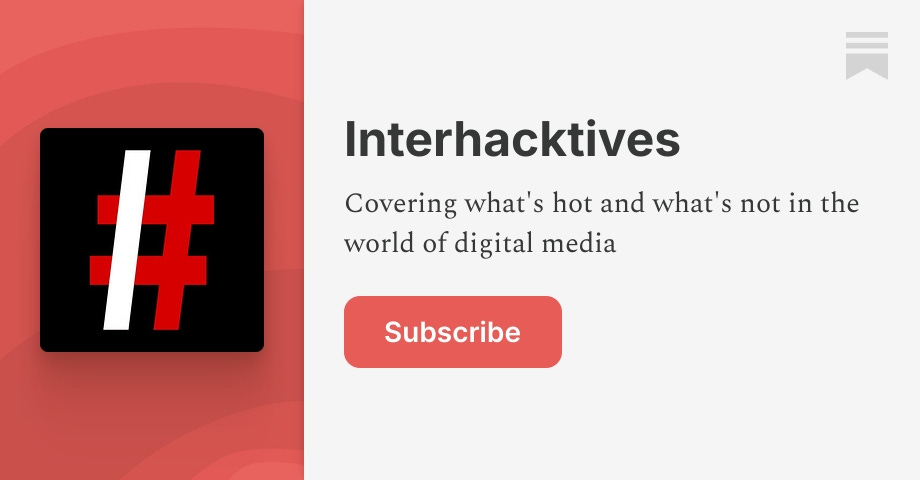What is a newsletter?
Rethinking how we conceptualise newsletters, why you should ignore the podcast doom-mongers and more in today’s updates.

At first glance, that looks like an easy question to answer. It’s a regularly delivered email with some editorial content, right? Simple! And yet, that description doesn’t really catch the complexity developing in the form. It’s a bit like describing a magazine as “printed paper, folded, collated and bound”: technically accurate, but not truly conveying the complexity of the form.
In my experience, most publishers still default to seeing newsletters as a promotional tool: a glorified list of links to bring the readers back to the “real” product — the websites. And sure, that’s a valuable thing to do. Newsletters are one of the few direct audience engagement tools we have. Getting people to transition from being a search- or social-driven visitor to being one that comes via a newsletter is a huge win.
Newsletters as engagement tool
Certainly, there’s growing evidence that newsletters are a powerful audience development tool. The FT’s head of newsletters (and OM&HB reader) Sarah Ebner is quoted in a summary of a new INMA report saying that “newsletter readers read 300% more articles on average than your other FT readers”, which reinforces the role of newsletters in building reader relationships. For any subscription business, decreasing churn by upping subscriber engagement with content is essential.
But equally, she was on the Media Voices podcast just last week, saying that some of the FT’s newsletters are products in their own right. Certainly, the fact that publishers from the FT to The Atlantic are making some newsletters a subscriber benefit rather than a free promotional tool, should be shifting people’s perception by now. But too many newsletters I see emerging from traditional publishers still clearly show that they haven’t moved beyond promotional thinking.
Product or promotional tool?
I have a game I sometimes make my long-suffering students play: promotion or a product? Is that newsletter used to encourage people to use the “main” product — usually a website, but not always — or is it a product in its own right? It’s surprisingly challenging to play because many newsletters have elements of both. And my point is that it’s a feature, not a bug.
It’s clear that some newsletters are inherently the products in their own right — the majority of the newsletters published via Substack or Beehiiv, for example, are just that — and often ones you pay for. (Ghost is slightly more complex, as it’s just as powerful as a member-model website builder as it is a newsletter platform). The “website” that exists on the platform is more a promotional product to attract sign-ups than the core of the business.
But then, there are newsletters like the one I publish, which a fairly significant chunk of the readership use mainly as a prompt to come check out the post on the web. About 10% of readers click straight through to read it in their browser as soon as it arrives. So, even though I write the post to be read in its entirety as an email, many people treat it as a promotional tool to alert them to a new post on the website.
This is clearly a complex situation that my primitive dichotomy of product or promotional tool doesn’t really capture. Like those publishers, it’s time for me to up my game, both literally and figuratively.
A new distinction
And so, I think we need to use different language. All newsletters need to be thought of as products in their own right, with the requisite work on purpose, concept, and personas that their status as a product implies. As part of that conceptual product work, you can define if the main purpose of the newsletter is promotional or paid, or what balance of the two it plays.
If you’re taking newsletters seriously — and if you aren’t, why the hell not? — then you must move away from looking it as a list of links with some fancy additions, and really think of it as a mini-magazine, delivered by email. It needs to contain its own inherent value, as well as being a gateway to other information on your site or those of others.
The days of the “content vomit” of links to all your latest stories with a little context are over. Evolve or be left behind.
Download the report
(INMA members only)

Bing AI chat search isn’t ready yet, part 27
An announcement from Microsoft, explained by Danny Goodwin at Search Engine Land:
Chat sessions on the new Bing are now capped at 50 chat “turns” per day and 5 chat “turns” per session. A “turn” is a conversation exchange which contains both a user question and a reply from Bing, Microsoft explained.
This, is presumably, to stop examples of the “bad Bing” dubbed Sydney by Ben Thompson emerging. Again I say, this tech is not ready for primetime, and is only being pushed out for marketing advantage.
Watch, learn — but don’t worry yet.
And if you need a quick catch-up, Neville’s written a useful summary of what’s afoot:

The Interhacktives newsletter is back
The spring term at City is when I run the Audience Strategy module for students on the Interactive Journalism MA. And that means that their site — Interhacktives — kicks into life. Katie Jones has taken charge of the newsletter, and you can grab yourself a subscription to weekly issues here:

Premature Podcasting Death Notice
Esther in today’s Media Roundup newsletter:
Honestly, I've got a bit fed up of the wave of doom-mongers who have proclaimed the death of podcasting following a drop-off in the number of new launches over the past twelve months. Just because Dave isn't launching any more shows from his bedroom chatting to his mates doesn't mean we've remotely hit the ceiling for professional podcasts.
This always happens. This is at least the second time that people have written off podcasting. Remember when The Guardian forgot that it had done a daily news podcast before?
Just because the explosive growth in a new(ish) medium is over doesn’t mean that it’s dead — but our colleagues too often report it that way. I got so hacked off with people saying that about blogging a few years ago that I actually had a category of posts for “premature blogging death notices”.
It’ll come for newsletters next. Ignore it. It’s poor, shallow reporting and should have no impact on your own planning.
Quickies
- 🕺🏼Talking of the Media Voices crew, here’s Chris giving some context for TikTok’s growth in Europe.
- 💃🏻 TikTok is running an invite-only beta of a Creativity Program in the US. The important bit? They’re asking the creators to make videos more than one minute long. Sounds like they’re trying to push gently into longer video. Worth watching.
- 🐦 A guide to setting up Twitter 2FA on your iOS device. For context, see yesterday’s post.
- 📈 Some more detailed metrics to consider if you’re serious about newsletters.
How phone cameras have changed
In 2005, I visited Universal Studios Orlando and took photos with my Treo smartphone. Last week, I went to Universal Studios Hollywood and took them with my iPhone 14. See if you can see tell which photo is which. pic.twitter.com/esSjqNwlYl
— Harry McCracken 🇺🇦 (@harrymccracken) February 18, 2023







